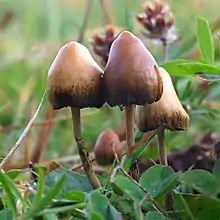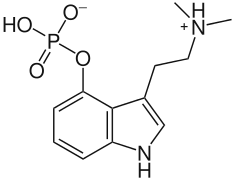Psilocybin mushroom
Psilocybin mushrooms, commonly known as magic mushrooms, are a polyphyletic informal group of fungi that contain psilocybin which turns into psilocin upon ingestion.[1][2] Biological genera containing psilocybin mushrooms include Copelandia, Gymnopilus, Inocybe, Panaeolus, Pholiotina, Pluteus, and Psilocybe. Psilocybin mushrooms have been and continue to be used in indigenous New World cultures in religious, divinatory, or spiritual contexts.[3] Psilocybin mushrooms are also used as recreational drugs. They may be depicted in Stone Age rock art in Africa and Europe, but are most famously represented in the Pre-Columbian sculptures and glyphs seen throughout North, Central and South America.
History
Early
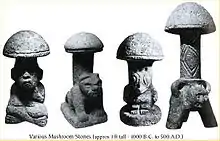
Prehistoric rock arts near Villar del Humo in Spain, suggests that Psilocybe hispanica was used in religious rituals 6,000 years ago.[4] The hallucinogenic[5] species of the Psilocybe genus have a history of use among the native peoples of Mesoamerica for religious communion, divination, and healing, from pre-Columbian times to the present day.[6] Mushroom stones and motifs have been found in Guatemala.[7] A statuette dating from ca. 200 CE. depicting a mushroom strongly resembling Psilocybe mexicana was found in the west Mexican state of Colima in a shaft and chamber tomb. A Psilocybe species known to the Aztecs as teōnanācatl (literally "divine mushroom": agglutinative form of teōtl (god, sacred) and nanācatl (mushroom) in Nahuatl language) was reportedly served at the coronation of the Aztec ruler Moctezuma II in 1502. Aztecs and Mazatecs referred to psilocybin mushrooms as genius mushrooms, divinatory mushrooms, and wondrous mushrooms, when translated into English.[8] Bernardino de Sahagún reported the ritualistic use of teonanácatl by the Aztecs when he traveled to Central America after the expedition of Hernán Cortés.[9]
After the Spanish conquest, Catholic missionaries campaigned against the cultural tradition of the Aztecs, dismissing the Aztecs as idolaters, and the use of hallucinogenic plants and mushrooms, together with other pre-Christian traditions, was quickly suppressed.[7] The Spanish believed the mushroom allowed the Aztecs and others to communicate with demons. Despite this history the use of teonanácatl has persisted in some remote areas.[3]
Modern
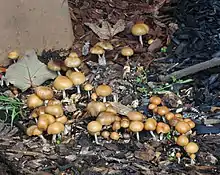
The first mention of hallucinogenic mushrooms in European medicinal literature was in the London Medical and Physical Journal in 1799: a man served Psilocybe semilanceata mushrooms he had picked for breakfast in London's Green Park to his family. The apothecary who treated them later described how the youngest child "was attacked with fits of immoderate laughter, nor could the threats of his father or mother refrain him."[10]

In 1955, Valentina Pavlovna Wasson and R. Gordon Wasson became the first known European Americans to actively participate in an indigenous mushroom ceremony. The Wassons did much to publicize their experience, even publishing an article on their experiences in Life on May 13, 1957.[11] In 1956, Roger Heim identified the psychoactive mushroom the Wassons brought back from Mexico as Psilocybe,[12] and in 1958, Albert Hofmann first identified psilocybin and psilocin as the active compounds in these mushrooms.[13][14]
Inspired by the Wassons' Life article, Timothy Leary traveled to Mexico to experience psilocybin mushrooms himself. When he returned to Harvard in 1960, he and Richard Alpert started the Harvard Psilocybin Project, promoting psychological and religious study of psilocybin and other psychedelic drugs. Alpert and Leary sought out to conduct research with psilocybin on prisoners in the 1960s, testing its effects on recidivism.[15] This experiment reviewed the subjects six months later, and found that the recidivism rate had decreased beyond their expectation, below 40%. This, and another experiment administering psilocybin to graduate divinity students, showed controversy. Shortly after Leary and Alpert were dismissed from their jobs by Harvard in 1963, they turned their attention toward promoting the psychedelic experience to the nascent hippie counterculture.[16]
The popularization of entheogens by the Wassons, Leary, Terence McKenna, Robert Anton Wilson and many others led to an explosion in the use of psilocybin mushrooms throughout the world. By the early 1970s, many psilocybin mushroom species were described from temperate North America, Europe, and Asia and were widely collected. Books describing methods of cultivating large quantities of Psilocybe cubensis were also published. The availability of psilocybin mushrooms from wild and cultivated sources have made them one of the most widely used of the psychedelic drugs.
At present, psilocybin mushroom use has been reported among some groups spanning from central Mexico to Oaxaca, including groups of Nahua, Mixtecs, Mixe, Mazatecs, Zapotecs, and others.[3] An important figure of mushroom usage in Mexico was María Sabina,[17] who used native mushrooms, such as Psilocybe mexicana in her practice.
Occurrence
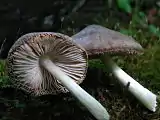


In a 2000 review on the worldwide distribution of psilocybin mushrooms, Gastón Guzmán and colleagues considered these distributed among the following genera: Psilocybe (116 species), Gymnopilus (14), Panaeolus (13), Copelandia (12), Pluteus (6) Inocybe (6), Pholiotina (4) and Galerina (1).[18] Guzmán increased his estimate of the number of psilocybin-containing Psilocybe to 144 species in a 2005 review.

Many of them are found in Mexico (53 species), with the remainder distributed throughout Canada and the US (22), Europe (16), Asia (15), Africa (4), and Australia and associated islands (19).[20] Generally, psilocybin-containing species are dark-spored, gilled mushrooms that grow in meadows and woods in the subtropics and tropics, usually in soils rich in humus and plant debris.[21] Psilocybin mushrooms occur on all continents, but the majority of species are found in subtropical humid forests.[18] P. cubensis is the most common Psilocybe in tropical areas. P. semilanceata, considered the world's most widely distributed psilocybin mushroom,[22] is found in temperate parts of Europe, North America, Asia, South America, Australia and New Zealand, although it is absent from Mexico.[20]
Composition
Magic mushroom composition varies from genus to genus and species to species.[23] Its principal component is psilocybin[24] which gets converted into psilocin to produce psychoactive effect. Besides, psilocin, norpsilocin, baeocystin, norbaeocystin and aeruginascin may also be present which can modify the effects of magic mushrooms.[23] Panaeolus subbalteatus, one species of magic mushroom, had highest amount of psilocybin compared to the rest of the fruiting body.[23] Certain mushrooms are found to produce beta-carbolines which inhibit monoamine oxidase, an enzyme that breaks down tryptamine alkaloids. They occur in different genera, such as Psilocybe,[25]Cyclocybe,[26] and Hygrophorus.[27] Harmine, harmane, norharmane and a range of other l-tryptophan-derived β-carbolines were discovered in Psilocybe species.
Effects
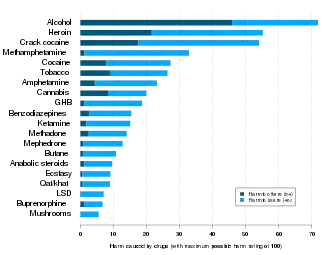

The effects of psilocybin mushrooms come from psilocybin and psilocin. When psilocybin is ingested, it is broken down by the liver in a process called dephosphorylation. The resulting compound is called psilocin, which is responsible for the psychedelic effects.[28] Psilocybin and psilocin create short-term increases in tolerance of users, thus making it difficult to misuse them because the more often they are taken within a short period of time, the weaker the resultant effects are.[29] Psilocybin mushrooms have not been known to cause physical or psychological dependence (addiction).[30] The psychedelic effects tend to appear around 20 minutes after ingestion and can last up to 6 hours. Physical effects including nausea, vomiting, euphoria, muscle weakness or relaxation, drowsiness, and lack of coordination may occur.
As with many psychedelic substances, the effects of psychedelic mushrooms are subjective and can vary considerably among individual users. The mind-altering effects of psilocybin-containing mushrooms typically last from three to eight hours depending on dosage, preparation method, and personal metabolism. The first 3–4 hours after ingestion are typically referred to as the 'peak'—in which the user experiences more vivid visuals and distortions in reality. The effects can seem to last much longer to the user because of psilocybin's ability to alter time perception.[31]
Sensory
Sensory effects include visual and auditory hallucinations followed by emotional changes and altered perception of time and space.[32] Noticeable changes to the auditory, visual, and tactile senses may become apparent around 30 minutes to an hour after ingestion, although effects may take up to two hours to take place. These shifts in perception visually include enhancement and contrasting of colors, strange light phenomena (such as auras or "halos" around light sources), increased visual acuity, surfaces that seem to ripple, shimmer, or breathe; complex open and closed eye visuals of form constants or images, objects that warp, morph, or change solid colours; a sense of melting into the environment, and trails behind moving objects. Sounds may seem to have increased clarity—music, for example, can take on a profound sense of cadence and depth.[32] Some users experience synesthesia, wherein they perceive, for example, a visualization of color upon hearing a particular sound.[33]
Emotional
As with other psychedelics such as LSD, the experience, or 'trip', is strongly dependent upon set and setting.[32] Hilarity, lack of concentration, and muscular relaxation (including dilated pupils) are all normal effects, sometimes in the same trip.[32] A negative environment could contribute to a bad trip, whereas a comfortable and familiar environment would set the stage for a pleasant experience. Psychedelics make experiences more intense, so if a person enters a trip in an anxious state of mind, they will likely experience heightened anxiety on their trip. Many users find it preferable to ingest the mushrooms with friends or people who are familiar with 'tripping'.[34] The psychological consequences of psilocybin use include hallucinations and an inability to discern fantasy from reality. Panic reactions and psychosis also may occur, particularly if a user ingests a large dose. In addition to the risks associated with ingestion of psilocybin, individuals who seek to use psilocybin mushrooms also risk poisoning if one of the many varieties of poisonous mushrooms is confused with a psilocybin mushroom.[35]
Dosage

Dosage of mushrooms containing psilocybin depends on the psilocybin and psilocin content of the mushroom which can vary significantly between and within the same species, but is typically around 0.5–2.0% of the dried weight of the mushroom. Usual doses of the common species Psilocybe cubensis range around 1.0 to 2.5 g, while about 2.5 to 5.0 g dried mushroom material is considered a strong dose. Above 5 g is often considered a heavy dose, with 5.0 grams of dried mushroom often being referred to as a "heroic dose".[36][37]
The concentration of active psilocybin mushroom compounds varies from species to species, but also from mushroom to mushroom within a given species, subspecies or variety.[38] In the species Psilocybe samuiensis, the dried cap of the mushroom contains the most psilocybin at about 0.23%–0.90%. The mycelium contains about 0.24%–0.32%.[39]
Research
Due partly to restrictions of the Controlled Substances Act, research in the United States was limited until the early 21st century when psilocybin mushrooms were tested for their potential to treat drug dependence, anxiety and mood disorders.[40][41] In 2018–19, the Food and Drug Administration (FDA) granted Breakthrough Therapy Designation for studies of psilocybin in depressive disorders.[42]
Legality
The legality of the cultivation, possession, and sale of psilocybin mushrooms and of psilocybin and psilocin varies from country to country.
See also
- List of psilocybin mushroom species
- List of psychoactive plants, fungi, and animals
- Psilocybin decriminalization in the United States
Citations
- Kuhn, Cynthia; Swartzwelder, Scott; Wilson, Wilkie (2003). Buzzed: The Straight Facts about the Most Used and Abused Drugs from Alcohol to Ecstasy. W.W. Norton & Company. p. 83. ISBN 978-0-393-32493-8.
- Canada, Health (January 12, 2012). "Magic mushrooms – Canada.ca". www.canada.ca. Archived from the original on December 22, 2017. Retrieved December 20, 2017.
- Guzmán G. (2008). "Hallucinogenic mushrooms in Mexico: An overview". Economic Botany. 62 (3): 404–412. doi:10.1007/s12231-008-9033-8. S2CID 22085876.
- Akers, Brian P.; Ruiz, Juan Francisco; Piper, Alan; Ruck, Carl A. P. (2011). "A Prehistoric Mural in Spain Depicting Neurotropic Psilocybe Mushrooms?1". Economic Botany. 65 (2): 121–128. doi:10.1007/s12231-011-9152-5. S2CID 3955222.
- Abuse, National Institute on Drug (April 22, 2019). "Hallucinogens DrugFacts". National Institute on Drug Abuse. Archived from the original on December 26, 2018. Retrieved December 27, 2020.
- F.J. Carod-Artal (January 1, 2015). "Hallucinogenic drugs in pre-Columbian Mesoamerican cultures". Neurología (English Edition). 30 (1): 42–49. doi:10.1016/j.nrleng.2011.07.010. PMID 21893367.
- Stamets (1996), p. 11.
- Stamets (1996), p. 7.
- Hofmann A. (1980). "The Mexican relatives of LSD". LSD: My Problem Child. New York City: McGraw-Hill. pp. 49–71. ISBN 978-0-07-029325-0.
- Brande E. (1799). "Mr. E. Brande, on a poisonous species of Agaric". The Medical and Physical Journal: Containing the Earliest Information on Subjects of Medicine, Surgery, Pharmacy, Chemistry and Natural History. 3 (11): 41–44. PMC 5659401. PMID 30490162.
- Wasson RG (1957). "Seeking the magic mushroom". Life. No. May 13. pp. 100–120.
- Heim R. (1957). "Notes préliminaires sur les agarics hallucinogènes du Mexique" [Preliminary notes on the hallucination-producing agarics of Mexico]. Revue de Mycologie (in French). 22 (1): 58–79.
- Hofmann A, Frey A, Ott H, Petrzilka T, Troxler F (1958). "Konstitutionsaufklärung und Synthese von Psilocybin" [The composition and synthesis of psilocybin]. Cellular and Molecular Life Sciences (in German). 14 (11): 397–399. doi:10.1007/BF02160424. PMID 13609599. S2CID 33692940.
- Hofmann A, Heim R, Brack A, Kobel H (1958). "Psilocybin, ein psychotroper Wirkstoff aus dem mexikanischen Rauschpilz Psilocybe mexicana Heim" [Psilocybin, a psychotropic drug from the Mexican magic mushroom Psilocybe mexicana Heim]. Experientia (in German). 14 (3): 107–109. doi:10.1007/BF02159243. PMID 13537892. S2CID 42898430.
- "Dr. Leary's Concord Prison Experiment: A 34 Year Follow-Up Study". Bulletin of the Multidisciplinary Association for Psychedelic Studies. 9 (4): 10–18. 1999. Archived from the original on March 23, 2021. Retrieved March 26, 2021.
- Lattin, Don (2010). The Harvard Psychedelic Club: How Timothy Leary, Ram Dass, Huston Smith, and Andrew Weil killed the fifties and ushered in a new age for America (1st ed.). New York: HarperOne. pp. 37–44. ISBN 978-0-06-165593-7.
- Monaghan, John D.; Cohen, Jeffrey H. (2000). "Thirty years of Oaxacan ethnography". In Monaghan, John; Edmonson, Barbara (eds.). Ethnology. Austin, Texas: University of Texas Press. p. 165. ISBN 978-0-292-70881-5.
- Guzmán, G.; Allen, J.W.; Gartz, J. (2000). "A worldwide geographical distribution of the neurotropic fungi, an analysis and discussion" (PDF). Annali del Museo Civico di Rovereto: Sezione Archeologia, Storia, Scienze Naturali. 14: 189–280. Archived (PDF) from the original on February 5, 2018. Retrieved April 5, 2022.
- Guzmán G, Allen JW, Gartz J (1998). "A worldwide geographical distribution of the neurotropic fungi, an analysis and discussion" (PDF). Annali del Museo Civico di Rovereto. 14: 207. Archived (PDF) from the original on June 26, 2010. Retrieved September 17, 2017.
- Guzmán, G. (2005). "Species diversity of the genus Psilocybe (Basidiomycotina, Agaricales, Strophariaceae) in the world mycobiota, with special attention to hallucinogenic properties". International Journal of Medicinal Mushrooms. 7 (1–2): 305–331. doi:10.1615/intjmedmushr.v7.i12.280.
- Wurst, M.; Kysilka, R.; Flieger, M. (2002). "Psychoactive tryptamines from Basidiomycetes". Folia Microbiologica. 47 (1): 3–27 [5]. doi:10.1007/BF02818560. PMID 11980266. S2CID 31056807.
- Guzmán, G. (1983). The Genus Psilocybe: A Systematic Revision of the Known Species Including the History, Distribution, and Chemistry of the Hallucinogenic Species. Beihefte Zur Nova Hedwigia. Vol. 74. Vaduz, Liechtenstein: J. Cramer. pp. 361–2. ISBN 978-3-7682-5474-8.
- "Chemical Composition Variability in Magic Mushrooms". March 4, 2019. Archived from the original on August 18, 2021. Retrieved August 17, 2021.
- "Hallucinogenic mushrooms drug profile". European Monitoring Centre for Drugs and Drug Addiction. Archived from the original on August 17, 2021. Retrieved August 17, 2021.
- Blei F, Dörner S, Fricke J, Baldeweg F, Trottmann F, Komor A, Meyer F, Hertweck C, Hoffmeister D (January 2020). "Simultaneous Production of Psilocybin and a Cocktail of β-Carboline Monoamine Oxidase Inhibitors in 'Magic' Mushrooms". Chemistry—A European Journal. 26 (3): 729–734. doi:10.1002/chem.201904363. PMC 7003923. PMID 31729089.
- Krüzselyi D, Vetter J, Ott PG, Darcsi A, Béni S, Gömöry Á, Drahos L, Zsila F, Móricz ÁM (September 2019). "Isolation and structural elucidation of a novel brunnein-type antioxidant β-carboline alkaloid from Cyclocybe cylindracea". Fitoterapia. 137: 104180. doi:10.1016/j.fitote.2019.104180. PMID 31150766. S2CID 172137046.
- Teichert A, Lübken T, Schmidt J, Kuhnt C, Huth M, Porzel A, Wessjohann L, Arnold N (2008). "Determination of beta-carboline alkaloids in fruiting bodies of Hygrophorus spp. by liquid chromatography/electrospray ionisation tandem mass spectrometry". Phytochemical Analysis. 19 (4): 335–41. doi:10.1002/pca.1057. PMID 18401852.
- Passie, T.; Seifert, J.; Schneider, und; Emrich, H.M. (2002). "The pharmacology of psilocybin". Addiction Biology. 7 (4): 357–364. doi:10.1080/1355621021000005937. PMID 14578010. S2CID 12656091.
- "Psilocybin Fast Facts". National Drug Intelligence Center. Archived from the original on May 12, 2007. Retrieved April 4, 2007.
- van Amsterdam, J.; Opperhuizen, A.; van den Brink, W. (2011). "Harm potential of magic mushroom use: A review". Regulatory Toxicology and Pharmacology. 59 (3): 423–429. doi:10.1016/j.yrtph.2011.01.006. PMID 21256914.
- Wittmann, M.; Carter, O.; Hasler, F.; Cahn, B.R.; Grimberg, und; Spring, P.; Hell, D.; Flohr, H.; Vollenweider, F.X. (2007). "Effects of psilocybin on time perception and temporal control of behaviour in humans". Journal of Psychopharmacology. 21 (1): 50–64. doi:10.1177/0269881106065859. PMID 16714323. S2CID 3165579.
- Schultes, Richard Evans (1976). Hallucinogenic Plants. Illustrated by Elmer W. Smith. New York: Golden Press. p. 68. ISBN 978-0-307-24362-1.
- Ballesteros, S.; Ramón, M.F.; Iturralde, M.J.; Martínez-Arrieta, R. (2006). "Natural Sources of Drugs of Abuse: Magic Mushrooms". In Cole, S.M. (ed.). New Research on Street Drugs. Nova Science Publishers. p. 175. ISBN 978-1-59454-961-8.
- Stamets (1996)
- "Psilocybin Fast Facts". National Drug Intelligence Center, US Department of Justice. Archived from the original on May 3, 2018. Retrieved May 3, 2018.
 This article incorporates text from this source, which is in the public domain.
This article incorporates text from this source, which is in the public domain. - "Terence McKenna's Last Trip". Wired Magazine. Condé Nast Publications. May 1, 2000. Archived from the original on March 14, 2014. Retrieved September 17, 2017.
- Jesso, James W. (June 13, 2013). Decomposing The Shadow: Lessons From The Psilocybin Mushroom. SoulsLantern Publishing. p. 90. ISBN 978-0-9919435-0-0.
- Bigwood J, Beug MW (1982). "Variation of psilocybin and psilocin levels with repeated flushes (harvests) of mature sporocarps of Psilocybe cubensis (Earle) Singer". Journal of Ethnopharmacology. 5 (3): 287–291. doi:10.1016/0378-8741(82)90014-9. PMID 7201054.
- Gartz J, Allen JW, Merlin MD (2004). "Ethnomycology, biochemistry, and cultivation of Psilocybe samuiensis Guzmán, Bandala and Allen, a new psychoactive fungus from Koh Samui, Thailand". Journal of Ethnopharmacology. 43 (2): 73–80. doi:10.1016/0378-8741(94)90006-X. PMID 7967658.
- Bui, Eric; King, Franklin; Melaragno, Andrew (December 1, 2019). "Pharmacotherapy of anxiety disorders in the 21st century: A call for novel approaches (Review)". General Psychiatry. 32 (6): e100136. doi:10.1136/gpsych-2019-100136. PMC 6936967. PMID 31922087.
- Doblin, Richard E.; Christiansen, Merete; Jerome, Lisa; Burge, Brad (March 15, 2019). "The Past and Future of Psychedelic Science: An Introduction to This Issue". Journal of Psychoactive Drugs. 51 (2): 93–97. doi:10.1080/02791072.2019.1606472. ISSN 0279-1072.
- "FDA grants Breakthrough Therapy Designation to Usona Institute's psilocybin program for major depressive disorder". www.businesswire.com. November 22, 2019. Archived from the original on October 26, 2021. Retrieved September 17, 2020.
General and cited references
- Allen, J.W. (1997). Magic Mushrooms of the Pacific Northwest. Seattle: Raver Books and John W. Allen. ISBN 978-1-58214-026-1.
- Estrada, A. (1981). Maria Sabina: Her Life and Chants. Ross Erikson. ISBN 978-0-915520-32-9.
- Haze, Virginia & Dr. K. Mandrake, PhD. The Psilocybin Mushroom Bible: The Definitive Guide to Growing and Using Magic Mushrooms. Green Candy Press: Toronto, Canada, 2016. ISBN 978-1-937866-28-0. www.greencandypress.com.
- Högberg, O. (2003). Flugsvampen och människan (in Swedish). ISBN 978-91-7203-555-3.
- Kuhn, C.; Swartzwelder, S; Wilson, W. (2003). Buzzed: The Straight Facts about the Most Used and Abused Drugs from Alcohol to Ecstasy. New York: W.W. Norton & Company. ISBN 978-0-393-32493-8.
- Letcher, A. (2006). Shroom: A Cultural History of the Magic Mushroom. London: Faber and Faber. ISBN 978-0-571-22770-9.
- McKenna, T. (1993). Food of the Gods. Bantam. ISBN 978-0-553-37130-7.
- Nicholas, L.G.; Ogame, K. (2006). Psilocybin Mushroom Handbook: Easy Indoor and Outdoor Cultivation. Quick American Archives. ISBN 978-0-932551-71-9.
- Stamets, P. (1993). Growing Gourmet and Medicinal Mushrooms. Berkeley: Ten Speed Press. ISBN 978-1-58008-175-7.
- Stamets, P.; Chilton, J.S. (1983). The Mushroom Cultivator. Olympia: Agarikon Press. ISBN 978-0-9610798-0-2.
- Stamets, P. (1996). Psilocybin Mushrooms of the World. Berkeley: Ten Speed Press. ISBN 978-0-9610798-0-2.
- Wasson, G.R. (1980). The Wondrous Mushroom: Mycolatry in Mesoamerica. McGraw-Hill. ISBN 978-0-07-068443-0.
External links
 The dictionary definition of magic mushroom at Wiktionary
The dictionary definition of magic mushroom at Wiktionary
